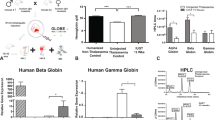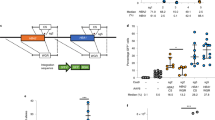Abstract
β-Globin locus control region (LCR) sequences have been widely used for the regulated expression of the human β-globin gene in therapeutic viral vectors. In this study, we compare the expression of the human β-globin gene from either the HS2/HS3 β-globin LCR or the HS40 regulatory element from the α-globin locus in the context of foamy virus (FV) vectors for the genetic correction of β-thalassemia. Both regulatory elements expressed comparable levels of human β-globin in a murine erythroleukemic line, whereas in murine hematopoietic stem cells the HS40.β vector proved more efficient in β-globin expression and correction of the β-thalassemia phenotype. Following transplantation in the Hbbth3/+ mouse model, the expression efficiency by the two vectors was similar, whereas the HS40.β vector achieved relatively more stable transgene expression. In addition, in an ex vivo assay using CD34+ cells from thalassemic patients, both vectors achieved significant human β-globin expression and restoration of the thalassemic phenotype as evidenced by enhanced erythropoiesis and decreased apoptosis. Our data suggest that FV vectors with the α-globin HS40 element can be used as alternative but equally efficient vehicles for human β-globin gene expression for the genetic correction of β-thalassemia.
This is a preview of subscription content, access via your institution
Access options
Subscribe to this journal
Receive 12 print issues and online access
$259.00 per year
only $21.58 per issue
Buy this article
- Purchase on Springer Link
- Instant access to full article PDF
Prices may be subject to local taxes which are calculated during checkout




Similar content being viewed by others
References
Isgro A, Gaziev J, Sodani P, Lucarelli G . Progress in hematopoietic stem cell transplantation as allogeneic cellular gene therapy in thalassemia. Ann NY Acad Sci 2010; 1202: 149–154.
Grosveld F, van Assendelft GB, Greaves DR, Kollias G . Position-independent, high-level expression of the human beta-globin gene in transgenic mice. Cell 1987; 51: 975–985.
Novak U, Harris EA, Forrester W, Groudine M, Gelinas R . High-level beta-globin expression after retroviral transfer of locus activation region-containing human beta-globin gene derivatives into murine erythroleukemia cells. Proc Natl Acad Sci USA 1990; 87: 3386–3390.
Miccio A, Cesari R, Lotti F, Rossi C, Sanvito F, Ponzoni M et al. In vivo selection of genetically modified erythroblastic progenitors leads to long-term correction of beta-thalassemia. Proc Natl Acad Sci USA 2008; 105: 10547–10552.
Roselli EA, Mezzadra R, Frittoli MC, Maruggi G, Biral E, Mavilio F et al. Correction of beta-thalassemia major by gene transfer in haematopoietic progenitors of pediatric patients. EMBO Mol Med 2010; 2: 315–328.
Li Q, Emery DW, Han H, Sun J, Yu M, Stamatoyannopoulos G . Differences of globin transgene expression in stably transfected cell lines and transgenic mice. Blood 2005; 105: 3346–3352.
Persons DA, Hargrove PW, Allay ER, Hanawa H, Nienhuis AW . The degree of phenotypic correction of murine beta -thalassemia intermedia following lentiviral-mediated transfer of a human gamma-globin gene is influenced by chromosomal position effects and vector copy number. Blood 2003; 101: 2175–2183.
Ren S, Wong BY, Li J, Luo XN, Wong PM, Atweh GF . Production of genetically stable high-titer retroviral vectors that carry a human gamma-globin gene under the control of the alpha-globin locus control region. Blood 1996; 87: 2518–2524.
Vassilopoulos G, Rethwilm A . The usefulness of a perfect parasite. Gene Therapy 2008; 15: 1299–1301.
Vassilopoulos G, Trobridge G, Josephson NC, Russell DW . Gene transfer into murine hematopoietic stem cells with helper-free foamy virus vectors. Blood 2001; 98: 604–609.
Kiem HP, Allen J, Trobridge G, Olson E, Keyser K, Peterson L et al. Foamy-virus-mediated gene transfer to canine repopulating cells. Blood 2007; 109: 65–70.
Andrianaki A, Siapati EK, Hirata RK, Russell DW, Vassilopoulos G . Dual transgene expression by foamy virus vectors carrying an endogenous bidirectional promoter. Gene Therapy 2010; 17: 380–388.
Trobridge GD, Miller DG, Jacobs MA, Allen JM, Kiem HP, Kaul R et al. Foamy virus vector integration sites in normal human cells. Proc Natl Acad Sci USA 2006; 103: 1498–1503.
Vassilopoulos G, Navas PA, Skarpidi E, Peterson KR, Lowrey CH, Papayannopoulou T et al. Correct function of the locus control region may require passage through a nonerythroid cellular environment. Blood 1999; 93: 703–712.
Morrison SJ, Hemmati HD, Wandycz AM, Weissman IL . The purification and characterization of fetal liver hematopoietic stem cells. Proc Natl Acad Sci USA 1995; 92: 10302–10306.
Socolovsky M, Nam H, Fleming MD, Haase VH, Brugnara C, Lodish HF . Ineffective erythropoiesis in Stat5a(−/−)5b(−/−) mice due to decreased survival of early erythroblasts. Blood 2001; 98: 3261–3273.
Rohaly J . The use of busulfan therapy in bone marrow transplantation. A nursing overview. Cancer Nurs 1989; 12: 144–152.
Cavazzana-Calvo M, Payen E, Negre O, Wang G, Hehir K, Fusil F et al. Transfusion independence and HMGA2 activation after gene therapy of human beta-thalassaemia. Nature 2010; 467: 318–322.
Wojda U, Noel P, Miller JL . Fetal and adult hemoglobin production during adult erythropoiesis: coordinate expression correlates with cell proliferation. Blood 2002; 99: 3005–3013.
Puthenveetil G, Scholes J, Carbonell D, Qureshi N, Xia P, Zeng L et al. Successful correction of the human beta-thalassemia major phenotype using a lentiviral vector. Blood 2004; 104: 3445–3453.
Anderson WF, Goldberg S, Kantoff P, Berg P, Eglitis M, Humphries RK . Attempts at gene therapy in beta-thalassemic mice. Ann NY Acad Sci 1985; 445: 445–451.
Cone RD, Weber-Benarous A, Baorto D, Mulligan RC . Regulated expression of a complete human beta-globin gene encoded by a transmissible retrovirus vector. Mol Cell Biol 1987; 7: 887–897.
Dzierzak EA, Papayannopoulou T, Mulligan RC . Lineage-specific expression of a human beta-globin gene in murine bone marrow transplant recipients reconstituted with retrovirus-transduced stem cells. Nature 1988; 331: 35–41.
Bender MA, Gelinas RE, Miller AD . A majority of mice show long-term expression of a human beta-globin gene after retrovirus transfer into hematopoietic stem cells. Mol Cell Biol 1989; 9: 1426–1434.
Fraser P, Hurst J, Collis P, Grosveld F . DNaseI hypersensitive sites 1, 2 and 3 of the human beta-globin dominant control region direct position-independent expression. Nucleic Acids Res 1990; 18: 3503–3508.
Caterina JJ, Ryan TM, Pawlik KM, Palmiter RD, Brinster RL, Behringer RR et al. Human beta-globin locus control region: analysis of the 5′ DNase I hypersensitive site HS 2 in transgenic mice. Proc Natl Acad Sci USA 1991; 88: 1626–1630.
Tuan DY, Solomon WB, London IM, Lee DP . An erythroid-specific, developmental-stage-independent enhancer far upstream of the human ‘beta-like globin’ genes. Proc Natl Acad Sci USA 1989; 86: 2554–2558.
Moi P, Kan YW . Synergistic enhancement of globin gene expression by activator protein-1-like proteins. Proc Natl Acad Sci USA 1990; 87: 9000–9004.
Sadelain M, Wang CH, Antoniou M, Grosveld F, Mulligan RC . Generation of a high-titer retroviral vector capable of expressing high levels of the human beta-globin gene. Proc Natl Acad Sci USA 1995; 92: 6728–6732.
May C, Rivella S, Callegari J, Heller G, Gaensler KM, Luzzatto L et al. Therapeutic haemoglobin synthesis in beta-thalassaemic mice expressing lentivirus-encoded human beta-globin. Nature 2000; 406: 82–86.
Sharpe JA, Chan-Thomas PS, Lida J, Ayyub H, Wood WG, Higgs DR . Analysis of the human alpha globin upstream regulatory element (HS-40) in transgenic mice. EMBO J 1992; 11: 4565–4572.
Chen H, Lowrey CH, Stamatoyannopoulos G . Analysis of enhancer function of the HS-40 core sequence of the human alpha-globin cluster. Nucleic Acids Res 1997; 25: 2917–2922.
Li Q, Emery DW, Fernandez M, Han H, Stamatoyannopoulos G . Development of viral vectors for gene therapy of beta-chain hemoglobinopathies: optimization of a gamma-globin gene expression cassette. Blood 1999; 93: 2208–2216.
Persons DA, Allay ER, Sabatino DE, Kelly P, Bodine DM, Nienhuis AW . Functional requirements for phenotypic correction of murine beta-thalassemia: implications for human gene therapy. Blood 2001; 97: 3275–3282.
Andreani M, Nesci S, Lucarelli G, Tonucci P, Rapa S, Angelucci E et al. Long-term survival of ex-thalassemic patients with persistent mixed chimerism after bone marrow transplantation. Bone Marrow Transplant 2000; 25: 401–404.
Rivella S, May C, Chadburn A, Riviere I, Sadelain M . A novel murine model of Cooley anemia and its rescue by lentiviral-mediated human beta-globin gene transfer. Blood 2003; 101: 2932–2939.
Epner E, Reik A, Cimbora D, Telling A, Bender MA, Fiering S et al. The beta-globin LCR is not necessary for an open chromatin structure or developmentally regulated transcription of the native mouse beta-globin locus. Mol Cell 1998; 2: 447–455.
Hendrie PC, Huo Y, Stolitenko RB, Russell DW . A rapid and quantitative assay for measuring neighboring gene activation by vector proviruses. Mol Ther 2008; 16: 534–540.
Plavec I, Papayannopoulou T, Maury C, Meyer F . A human beta-globin gene fused to the human beta-globin locus control region is expressed at high levels in erythroid cells of mice engrafted with retrovirus-transduced hematopoietic stem cells. Blood 1993; 81: 1384–1392.
Walsh CE, Liu JM, Miller JL, Nienhuis AW, Samulski RJ . Gene therapy for human hemoglobinopathies. Proc Soc Exp Biol Med 1993; 204: 289–300.
Vassilopoulos G, Josephson NC, Trobridge G . Development of foamy virus vectors. Methods Mol Med 2003; 76: 545–564.
Livak KJ, Schmittgen TD . Analysis of relative gene expression data using real-time quantitative PCR and the 2(−Delta Delta C(T)) Method. Methods 2001; 25: 402–408.
Acknowledgements
We thank Dr G Stamatoyannopoulos, Q Li and D Emery from the University of Washington (Seattle, WA) for the HS40 plasmid; Dr N Anagnou for providing the Hbbth3/+ mice; and Drs E Gouseti, S Grafako and A Kattamis (Children's Hospital, Agia Sofia, Athens, Greece) for providing β-thalassemia patient samples. The work was supported from an EU grant (CONSERT LSHB-CT-2004-005242) and a grant from the Greek GSRT (PENED 603).
Author information
Authors and Affiliations
Corresponding author
Ethics declarations
Competing interests
The authors declare no conflict of interest.
Rights and permissions
About this article
Cite this article
Morianos, I., Siapati, E., Pongas, G. et al. Comparative analysis of FV vectors with human α- or β-globin gene regulatory elements for the correction of β-thalassemia. Gene Ther 19, 303–311 (2012). https://doi.org/10.1038/gt.2011.98
Received:
Revised:
Accepted:
Published:
Issue Date:
DOI: https://doi.org/10.1038/gt.2011.98



